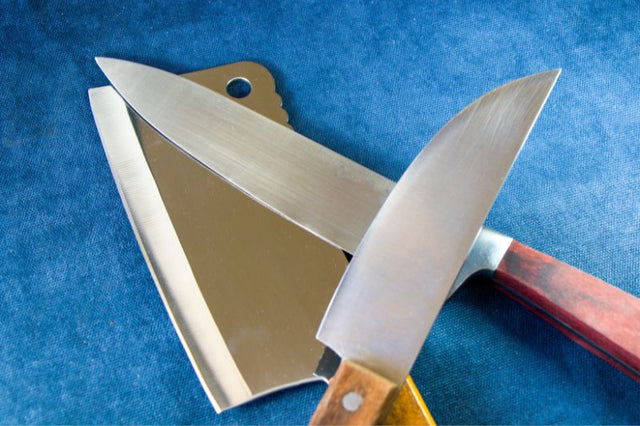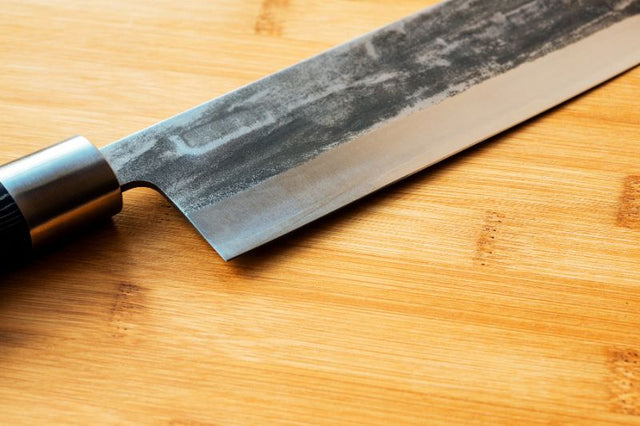All you wanted was a cool-looking Japanese knife, but suddenly retailers and knife connoisseurs are throwing facts and numbers at you. Among the dozen other statistics and buzzwords, they keep mentioning the 'HRC' number and the 'Rockwell Hardness Scale,' but you haven't got a clue what they're talking about.
What Is HRC?
When buying a knife, one of the most important factors is the hardness of the material, as this can dramatically change the performance of a knife. Therefore, an HRC rating is something to look out for when comparing knives, as it gives you an idea of how hard the steel of a knife is. But, although the Rockwell Hardness Scale provides essential information, it's a more complex issue than many think.
What’s better, a higher or lower HRC number? Does it even matter?
In this article, I will take you through the history and use of the Rockwell Hardness Scale. Then, I'll dispel a few misconceptions so you can look beyond marketing to make the right decision. Soon enough, you'll know the ins and outs of the scale, but before I get into whether or not high HRC is a good thing, let's look at how knife steels got their HRC numbers in the first place.

A Brief History of the Rockwell Hardness Scale
Hugh M. Rockwell and Stanley P. Rockwell (who weren't related but conveniently had the same last name) patented the technology in 1919 for testing materials in the construction of automobile bearings. Until then, other types of hardness tests had destroyed the test materials and weren't as accurate. The Rockwell Hardness Test didn't require significant damage to the test material, so it could perform multiple tests easily on the same piece of material. In addition, the testing machine itself was sturdy and easy to use.
The Spread of the Rockwell Hardness Tester
Stanley Rockwell then went on to team up with the president of Wilson Mechanical Instrument Co., Charles H. Wilson, to commercialize the Rockwell Hardness Tester. Wilson was granted a U.S. patent in 1932 for a commercial version, which has since become a popular way for many industries to check the hardness of materials. The design of the machine has mostly stayed the same since the original patent, but the more current models feature digital LCD screens and require less input from the user.
How a Rockwell Hardness Test is Done
The test is done using a small sample of the material that needs to be tested and a hydraulic machine, the aforementioned Rockwell Hardness Tester. The machine presses a small cone-tipped indenter into the material (for example, a piece of steel) using an exact amount of force. It starts with a shallow indentation and then a deeper one, measuring the two. That's how the machine gauges the hardness of the material and gives it a number on the scale. A high number means the material is harder, and a lower number means it's softer.
HRC, or Hardness Rockwell C
HRC stands for Hardness Rockwell C. There are 30 different scales for various materials. For instance, there are scales for softer metals such as copper (HRB) or plastics (HRM). The C scale is used specifically for very hard materials such as steel. You don't have to worry about the other scales as they aren't used to measure the hardness of knife steels. That's why you'll only ever see an HRC number with regard to knives and not HRM or HRB.
HRC Test
While all of the scales are measured in the same manner, certain variables change. For example, a diamond brale indenter is used to perform the HRC test because of the hardness of the material being tested. On top of that, 150 kilograms of force is needed to make a tiny indentation into the steel. Because steel isn't necessarily wholly uniform in every spot, and to account for errors, this test is usually done several times to get a range of numbers. That's partially why you'll sometimes see HRC numbers given as, for example, a range (HRC 58 - 60) or as a minimum value (HRC 58+).
Different Knife Makers, Different HRCs
But, while a steel manufacturer might give their steel an HRC number, this is only the hardness of the steel from the factory. Once knife manufacturers and bladesmiths get their hands on the material, they can make it even harder through various heat treatments. That's why you'll find knives made from the same steel but by different knife manufacturers with varying HRC numbers.

Is High HRC Important For My Knife?
Okay, now we know that a knife with a high HRC number means it has harder steel. That means it's better, right? Well, the answer is both yes and no. It's a little more complicated than that. Generally speaking, yes, a harder knife will mean a lot of good things are coming your way: better wear resistance, good edge retention, and toughness. And additionally, a harder steel knife can often have its edge sharpened to a smaller angle, making it much better for fine cutting.
But There Are Downsides
Harder steels tend to be more brittle. So, if you choose a super-hard knife, it will be more prone to chipping, shattering, and snapping. Usually, this isn't a problem if proper care is taken with a knife. Just avoid cutting frozen foods, bones or using your knife for anything outside the kitchen. But, if you were buying a knife to use in an environment where it needs to be more durable, for example, while camping, you may want a lower HRC knife, trading off some sharpness for something less brittle.
Hard to Dull, Hard to Sharpen
There is another consideration too. If you prefer sharpening your knife yourself, you will find that a higher HRC steel will be much more difficult to sharpen. When the HRC starts getting beyond 63, it is a good idea to ask a professional to sharpen your knife for you. That can be an extra cost of maintaining a knife that some people may not be able to afford. However, you won't often need to sharpen a very hard knife, especially if you take good care of it. Whereas a "softer" knife, around 56 - 60 HRC, you can easily maintain yourself, but it will need more frequent sharpening. Most Japanese knives sit around a sweet spot of 58 - 62 HRC, with good edge retention but still able to be sharpened at home.
The High Price of a Fine Edge
Generally speaking, the higher the steel HRC, the more expensive the knife. However, unless you're a knife expert or a professional chef, there will be diminishing returns in the cutting difference you perceive. So, while it's a great idea to invest in a good knife (they can last you a lifetime), you may not want to put all your money into a top-of-the-line knife made with the most expensive steel until you're experienced enough to appreciate the difference. Even some lower-end to mid-ranged Japanese knives are of exceptional quality. That's because a knife made by a great manufacturer will always be better than one made by a lousy manufacturer, regardless of the steel.
Technique and Other Elements
As discussed, the same steel in different hands will produce a very different knife. A perfect example is carbon steel, like White Steel. Although White Steel is not as "sophisticated" as other elaborate alloy steels, it is often found in some of the most expertly made knives. That's because it is notoriously tricky for bladesmiths to work with and requires the utmost care and expertise to shape without breaking it. So, there are much higher HRC steels than White Steel, but they aren't necessarily going to be sharper or better if they aren't made with the same precision.
The Best HRC
In some ways, It’s not about how high the HRC of steel is. It’s about the correct HRC for that type of steel. When a knife manufacturer gets the optimal HRC for a kind of steel, the different elements in that steel can do a better job. Otherwise, the steel might become too brittle or too soft. This is all done through various heat treatments in the knife-making process. If the correct HRC is achieved, all of the elements in the steel (molybdenum, cobalt, vanadium, etc.) work even better. That means the knife will have better wear resistance, edge retention, and toughness.
The Right HRC For You
It's always going to be about the use and the user. But, yes, a high HRC often indicates a quality knife with a long-lasting edge. Just keep in mind what you're using the knife for. Japanese kitchen knives come in all shapes and sizes for different tasks, and you may want a variety of knives with different hardness for each job. Know your knife budget, but be bold and invest in good quality. When you find a knife you like, ensure the manufacturer has a good reputation. And, what matters more than anything, or anyone else's opinion, is that the knife feels good to you when you use it.
Get Free Bonus Books

Sign up for free to the Japanese Knife Club to get advice and exclusive articles about how to choose Japanese Knives, and tips and tricks for using Japanese knives.
About the author
Kei Nishida
Author, CEO Dream of Japan
Certification: PMP, BS in Computer Science
Education: Western Washington University
Kei Nishida is a passionate advocate of Japanese craftsmanship, a writer, and the founder and CEO of Japanese Knife Co., Japanese Green Tea Co., and Japanese Coffee Co., all part of Dream of Japan.
His journey began with a mission to introduce the world to the exquisite flavors of Japanese green tea. Through Japanese Green Tea Co., he pioneered the import of premium tea grown in nutrient-rich sugarcane soil, earning multiple Global Tea Champion awards. He then expanded into the world of coffee, launching Japanese Coffee Co., the first company to bring Sumiyaki charcoal-roasted coffee to a global audience.
With a deep appreciation for Japanese artistry and tradition, Kei turned his attention to one of Japan’s most revered crafts: bladesmithing. Through Japanese Knife Co., he made handcrafted katana-style knives, created by a renowned katana maker, available outside Japan for the first time. These exceptional knives embody centuries of samurai sword-making expertise, blending tradition with modern functionality for chefs and collectors alike.
Kei’s journey continues as he uncovers and shares Japan’s hidden treasures—one sip, one blade, and one legacy at a time.



















